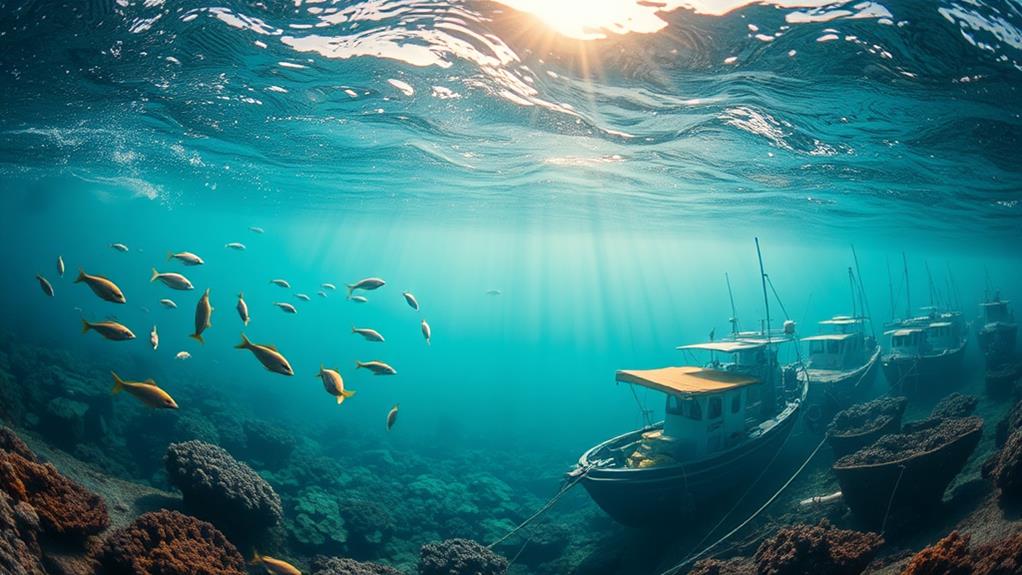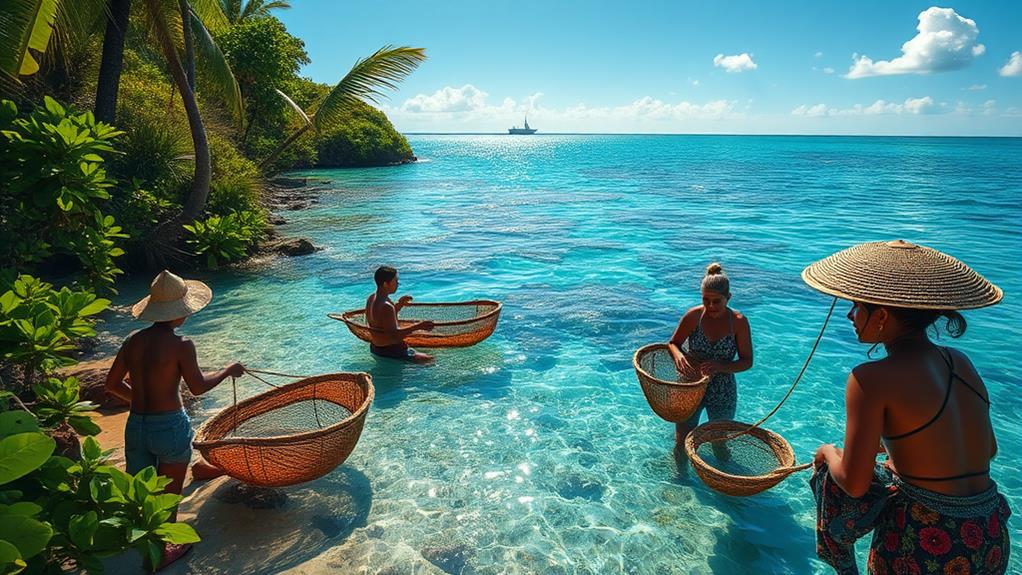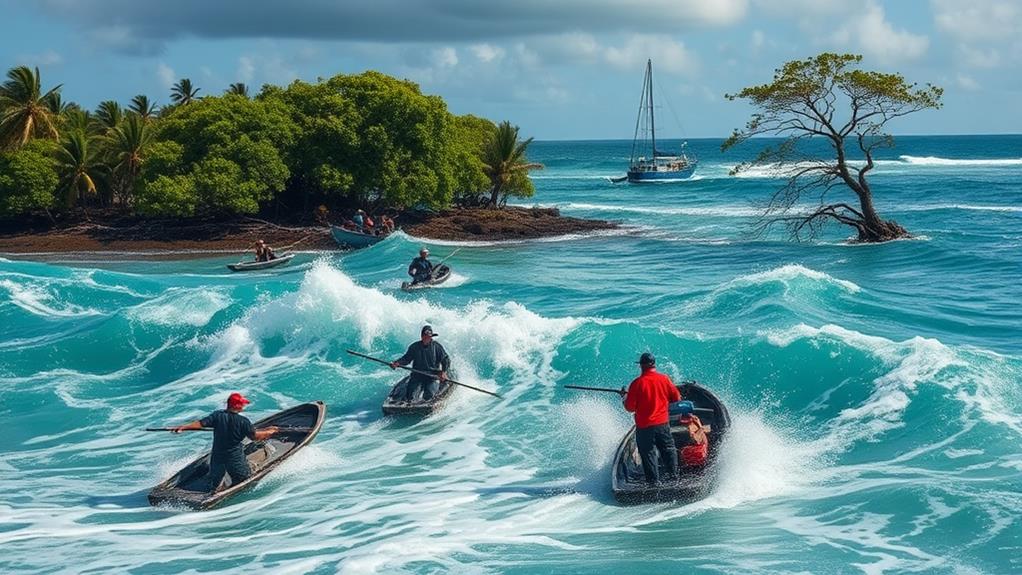The fishing industry in the Philippines is important for food security and jobs. It employs over 2 million people.
However, there are challenges like illegal fishing and climate change that threaten this industry. Reports show that if current practices continue, fish populations could be depleted by 2048.
To address these issues, community-based management and sustainable practices are needed. For example, creating Marine Protected Areas helps preserve fish habitats.
These changes can lead to more fish availability and support local markets.
There are also opportunities for growth. Aquaculture, or fish farming, can increase fish supply.
Additionally, eco-labeling can attract consumers who care about sustainability. By exploring these strategies, the fishing industry can become more sustainable and resilient.
Current State of Philippine Fisheries

The Philippine fishing industry is one of the largest in the world, ranking as the 11th largest seafood producer, with annual catches exceeding 4 million tonnes. Most of this seafood, over 85%, comes from small-scale fisheries. These small operations are crucial because they provide jobs and support the livelihoods of around 2.1 million Filipinos who depend on fishing for income and food.
However, there are serious problems with how fisheries are managed. About 40% of wild-caught seafood is tied to illegal, unreported, and unregulated (IUU) fishing. This illegal activity harms fish populations and disrupts marine ecosystems, which makes responsible management very important for the future of the industry.
More than half of the population relies on fish and other aquatic resources for their protein. Therefore, there's an urgent need for sustainable fisheries.
Effective management strategies can help prevent overfishing, protect marine environments, and ensure food security for many people. It's crucial to promote responsible fishing practices to benefit both the ecosystem and the communities that rely on fishing.
Key Challenges Facing the Industry
The Philippine fishing industry faces serious challenges that must be addressed. One major issue is illegal, unreported, and unregulated (IUU) fishing, which makes up up to 40% of all wild-caught seafood. This results in a loss of about 62 billion pesos each year, harming both fish populations and sustainable fishing methods.
Overfishing is another significant problem, made worse by climate change factors like rising sea temperatures and ocean acidification. These issues have led to lower fish catches, affecting the livelihoods of millions of Filipino fishers.
Small-scale fishers, who produce about 55% of seafood from local waters, are particularly at risk.
The UN warns that if unsustainable fishing practices continue, the Philippines could run out of fish by 2048. Additionally, the lack of transparency in seafood supply chains makes it difficult to enforce rules that promote sustainability.
To ensure a healthy future for the fishing industry, it's essential to urgently tackle these challenges.
Sustainable Practices and Strategies

Addressing illegal fishing and overfishing is essential for creating sustainable practices in the Philippine fishing industry. Sustainable practices help ensure that fishing can continue for future generations. The Philippines has established six management themes focused on balancing economic, social, and environmental goals, especially for large-scale fishers.
Artisanal and small-scale fisheries are vital for sustainability. They account for about 85% of wild-caught seafood. Organizations like Better Seafood Philippines (BSP) help fishers and processors learn and use sustainable handling methods. This protects both the environment and the livelihoods of the fishers.
Programs like USAID's Fish Right Activity focus on improving fishing practices. They use ecosystem-based fisheries management and train over 6,100 people in strategies to adapt to climate change.
| Sustainable Practices | Impact |
|---|---|
| Marine Protected Areas | Conserves biodiversity |
| Ecosystem-based Management | Promotes long-term sustainability |
| Climate Change Adaptation | Increases resilience of fisheries |
| Capacity Building for Fishers | Enhances livelihoods |
| Community Engagement | Fosters collective responsibility |
Role of Local Communities
Local communities are essential for sustainable fisheries in the Philippines. Over 85% of wild-caught seafood comes from artisanal fisheries, making your involvement crucial.
Around 2.1 million Filipinos depend on seafood-related jobs, emphasizing the importance of sustainable fishing.
Organizations like Better Seafood Philippines (BSP) highlight your role in developing systems suited to the local market. By educating others about seafood sustainability, you can impact both buyers and consumers.
Community-based fisheries management programs allow you to manage resources wisely, which helps protect fish stocks and marine habitats.
Local fisherfolk have experienced positive changes due to sustainable practices. They often report better catch availability and lower travel costs.
This shows that when communities engage in sustainable fishing, it not only helps their livelihoods but also benefits the health of marine ecosystems.
Your involvement is vital, and together, you can support practices that benefit both your community and the environment.
What are the potential challenges and opportunities for sustainable fish farming in the Philippines, as discussed in the fishing industry article?
The fishing industry article highlighted the potential challenges and opportunities for “innovations in sustainable aquaculture” in the Philippines. Key challenges include environmental impact and resource management, while opportunities lie in meeting the growing demand for seafood and creating economic benefits for local communities through sustainable fish farming practices.
Impact of Climate Change

Sustainable fishing practices are essential for supporting local communities, but they face serious threats from climate change. In the Philippines, the fisheries sector has been severely affected by rising sea temperatures and extreme weather events. These changes result in lower fish catches and damaged marine resources, which hurt the livelihoods of millions of people who depend on fishing for food.
For example, Typhoon Haiyan in 2013 showed how vulnerable fishing communities are to climate-related disasters. Such disasters make it more difficult for fisherfolk to continue sustainable practices.
Additionally, ocean acidification, caused by climate change, threatens marine life by reducing fish stocks and harming the biodiversity needed for healthy fisheries.
Currently, millions of fisherfolk are dealing with less fish and higher costs because of environmental changes. If we don't take action, the fishing industry could collapse, threatening food security and economic stability for many families.
It's important to understand these impacts to create strategies that protect the environment and the communities reliant on it.
Future Opportunities for Growth
The fishing industry in the Philippines has a great opportunity for growth. As the 11th largest seafood producer in the world, there is potential to expand aquaculture and improve food security for the country's 111 million people. Focusing on sustainable practices can increase fish production while helping small-scale fishers, who make up over 85% of wild-caught production.
Here are some growth strategies:
| Opportunities | Benefits |
|---|---|
| Community-based fisheries | This allows fishers to have better market access. |
| Eco-labeling initiatives | These attract consumers who care about the environment. |
| Investments in infrastructure | This boosts the local economy and enhances viability. |
| Collaborations with stakeholders | These improve the resilience of marine resources. |
Questions and Answers
What Are the Challenges in Fisheries Sector in the Philippines?
Overfishing regulations are often challenged by the needs of coastal communities. For example, local fishers may depend on catching more fish than is sustainable to support their families. This leads to overfishing, which harms fish populations. Additionally, innovation in aquaculture, or fish farming, is slow in the Philippines. Many farms use outdated methods, which can lead to less efficient production and environmental issues, such as pollution. These problems make it hard to manage fishery resources effectively. Ultimately, these factors threaten the health of future fish populations in the Philippines.
What Is the Situation of the Fisheries Resources of the Philippines Right Now?
The Philippines is currently facing serious issues with managing its fisheries. Marine biodiversity is decreasing. This means that many types of fish and other sea creatures are becoming less common. For example, overfishing and pollution are major threats to fish populations.
Aquaculture development is growing. This refers to raising fish and other aquatic animals in controlled environments. However, it is important to use sustainable practices in aquaculture. This means that we should avoid harming the environment while farming fish. For example, using natural feed instead of chemicals can help keep the ecosystem healthy.
Protecting fish resources is necessary for future generations. Without careful management, we risk losing important species and the livelihoods of many people who depend on fishing.
What Are the Sustainability Problems Involving Fisheries?
Overfishing, habitat degradation, and illegal fishing are major problems for marine ecosystems. Overfishing occurs when fish are caught faster than they can reproduce, leading to fewer fish in the ocean. For example, the Atlantic cod fishery in Canada collapsed due to overfishing, which hurt local economies. Habitat degradation happens when important areas for fish breeding and feeding are damaged. An example is the destruction of coral reefs, which serves as homes for many fish species. Illegal fishing is when people catch fish without permission or in restricted areas. This practice not only reduces fish populations but also harms communities that depend on healthy fisheries for jobs and cultural practices.
What Is the Future of the Fishing Industry in the Philippines?
The future of the fishing industry in the Philippines will include innovations in aquaculture, which is the farming of fish and other aquatic animals. For example, using new technologies can help raise fish in a controlled environment, leading to healthier stocks and less impact on wild fish populations.
Coastal community engagement is also important. Communities that depend on fishing will be involved in decision-making about their resources. This ensures that local needs are met while protecting the environment.
Finally, advancements in fishery technology will improve how fish are caught and processed. For instance, using GPS and sonar can help fishermen find fish more efficiently, reducing bycatch and waste.